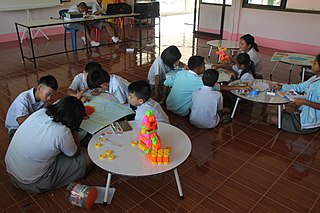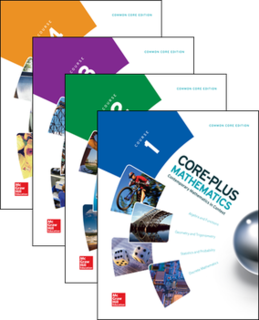Related Research Articles

Science education is the teaching and learning of science to school children, college students, or adults within the general public. The field of science education includes work in science content, science process, some social science, and some teaching pedagogy. The standards for science education provide expectations for the development of understanding for students through the entire course of their K-12 education and beyond. The traditional subjects included in the standards are physical, life, earth, space, and human sciences.

Homework, or a homework assignment, is a set of tasks assigned to students by their teachers to be completed outside the classroom. Common homework assignments may include required reading, a writing or typing project, mathematical exercises to be completed, information to be reviewed before a test, or other skills to be practiced.

Indiana State University (ISU) is a public university in Terre Haute, Indiana. It was founded in 1865 and offers over 100 undergraduate majors and more than 75 graduate and professional programs. Indiana State is classified among "D/PU: Doctoral/Professional Universities".

Student-centered learning, also known as learner-centered education, broadly encompasses methods of teaching that shift the focus of instruction from the teacher to the student. In original usage, student-centered learning aims to develop learner autonomy and independence by putting responsibility for the learning path in the hands of students by imparting to them skills, and the basis on how to learn a specific subject and schemata required to measure up to the specific performance requirement. Student-centered instruction focuses on skills and practices that enable lifelong learning and independent problem-solving. Student-centered learning theory and practice are based on the constructivist learning theory that emphasizes the learner's critical role in constructing meaning from new information and prior experience.

The No Child Left Behind Act of 2001 (NCLB) was a U.S. Act of Congress that reauthorized the Elementary and Secondary Education Act; it included Title I provisions applying to disadvantaged students. It supported standards-based education reform based on the premise that setting high standards and establishing measurable goals could improve individual outcomes in education. The Act required states to develop assessments in basic skills. To receive federal school funding, states had to give these assessments to all students at select grade levels.

The Indiana University School of Medicine (IUSM) is a major multi-campus medical school in the state of Indiana. There are nine campuses throughout the state; the principal research and medical center is located on the Indiana University–Purdue University Indianapolis campus in Indianapolis. With 1,409 M.D. Program students and 158 Ph.D. students in 2017, IUSM is one of the largest medical schools in the United States. The school offers several joint-degree programs, including an MD/MBA, MD/MA, MD/MPH, MD/MS, MD/JD, and an MD-PhD Medical Scientist Training Program. The university is the American medical school with the largest number of physicians in the United States per the 2018 Federation of State Medical Boards Survey with 11,828 licensed physicians.
A cognitive tutor is a particular kind of intelligent tutoring system that utilizes a cognitive model to provide feedback to students as they are working through problems. This feedback will immediately inform students of the correctness, or incorrectness, of their actions in the tutor interface; however, cognitive tutors also have the ability to provide context-sensitive hints and instruction to guide students towards reasonable next steps.

Project-based learning (PBL) is a student-centered pedagogy that involves a dynamic classroom approach in which it is believed that students acquire a deeper knowledge through active exploration of real-world challenges and problems. Students learn about a subject by working for an extended period of time to investigate and respond to a complex question, challenge, or problem. It is a style of active learning and inquiry-based learning. PBL contrasts with paper-based, rote memorization, or teacher-led instruction that presents established facts or portrays a smooth path to knowledge by instead posing questions, problems or scenarios.

The National Assessment of Educational Progress (NAEP) is the largest continuing and nationally representative assessment of what U.S. students know and can do in various subjects. NAEP is a congressionally mandated project administered by the National Center for Education Statistics (NCES), within the Institute of Education Sciences (IES) of the U.S. Department of Education. The first national administration of NAEP occurred in 1969. The National Assessment Governing Board (NAGB) is an independent, bipartisan board that sets policy for NAEP and is responsible for developing the framework and test specifications.The National Assessment Governing Board, whose members are appointed by the U.S. Secretary of Education, includes governors, state legislators, local and state school officials, educators, business representatives, and members of the general public. Congress created the 26-member Governing Board in 1988.

Civic engagement or civic participation is any individual or group activity addressing issues of public concern. Civic engagement includes communities working together or individuals working alone in both political and non-political actions to protect public values or make a change in a community. The goal of civic engagement is to address public concerns and promote the quality of the community.

Student voice is the individual and collective perspective and actions of students within the context of learning and education. It is identified in schools as both a metaphorical practice and as a pragmatic concern. Tech educator Dennis Harper noted that student voice gives students "the ability to influence learning to include policies, programs, contexts and principles."

The Indiana University School of Education is a constituent school of Indiana University Bloomington and one of the top-ranked schools of education in the United States. It offers a range of degrees in professional education: a B.S. in teacher education, leading to a teaching license, M.S., education specialist (Ed.S.) and doctoral degrees.
The National Survey of Student Engagement (NSSE) is a survey mechanism used to measure the level of student participation at universities and colleges in Canada and the United States as it relates to learning and engagement. The results of the survey help administrators and professors to assess their students' student engagement. The survey targets first-year and senior students on campuses. NSSE developed ten student Engagement Indicators (EIs) that are categorized in four general themes: academic challenge, learning with peers, experiences with faculty, and campus environment. Since 2000, there have been over 1,600 colleges and universities that have opted to participate in the survey. Additionally, approximately 5 million students within those institutions have completed the engagement survey. Overall, NSSE assesses effective teaching practices and student engagement in educationally purposeful activities. The survey is administered and assessed by Indiana University School of Education Center for Postsecondary Research.

Core-Plus Mathematics is a high school mathematics program consisting of a four-year series of print and digital student textbooks and supporting materials for teachers, developed by the Core-Plus Mathematics Project (CPMP) at Western Michigan University, with funding from the National Science Foundation. Development of the program started in 1992. The first edition, entitled Contemporary Mathematics in Context: A Unified Approach, was completed in 1995. The third edition, entitled Core-Plus Mathematics: Contemporary Mathematics in Context, was published by McGraw-Hill Education in 2015.
Student engagement occurs when "students make a psychological investment in learning. They try hard to learn what school offers. They take pride not simply in earning the formal indicators of success (grades), but in understanding the material and incorporating or internalizing it in their lives." Since the U.S. college dropout rate for first-time-in college degree-seeking students is nearly 50% It is increasingly seen as an indicator of successful classroom instruction, and as a valued outcome of school reform. The phrase was identified in 1996 as "the latest buzzword in education circles." Students are engaged when they are involved in their work, persist despite challenges and obstacles, and take visible delight in accomplishing their work. Student engagement also refers to a "student's willingness, need, desire and compulsion to participate in, and be successful in, the learning process promoting higher level thinking for enduring understanding." Student engagement is also a usefully ambiguous term for the complexity of 'engagement' beyond the fragmented domains of cognition, behaviour, emotion or affect, and in doing so encompass the historically situated individual within their contextual variables that at every moment influence how engaged an individual is in their learning.

As an educational reform goal, class size reduction (CSR) aims to increase the number of individualized student-teacher interactions intended to improve student learning. A reform long holding theoretical attraction to many constituencies, some have claimed CSR as the most studied educational reform of the last century. Until recently, interpretations of these studies have often been contentious. Some educational groups like the American Federation of Teachers and National Education Association are in favor of reducing class sizes. Others argue that class size reduction has little effect on student achievement. Many are concerned about the costs of reducing class sizes.
Ronald F. Ferguson in Cleveland, Ohio is an economist who researches factors that affect educational achievement. Major themes in his work include the race-related achievement gap in the United States and how to improve schools and identify effective teachers.
John T. Guthrie is a researcher and scholar in the area of student motivation as it relates to literacy.
Concept-Oriented Reading Instruction (CORI) was developed in 1993 by Dr. John T. Guthrie with a team of elementary teachers and graduate students. The project designed and implemented a framework of conceptually oriented reading instruction to improve students' amount and breadth of reading, intrinsic motivations for reading, and strategies of search and comprehension. The framework emphasized five phases of reading instruction in a content domain: observing and personalizing, searching and retrieving, comprehending and integrating, communicating to others, and interacting with peers to construct meaning. CORI instruction was contrasted to experience-based teaching and strategy instruction in terms of its support for motivational and cognitive development.
Disengagement compact is the name assigned by educator George Kuh in 1991 to the tacit agreement between college teachers and their students that if teachers will minimize academic demands and grade generously, students for their part will write favorable course reviews and will allow teachers undisturbed time to focus on the research and publishing that their institutions reward with promotions and tenure. Commentators in the United States and Canada attribute the disengagement compact to market forces acting since the 1960s. The disengagement compact has been most discussed — and lamented — by educators convinced that engagement with teachers builds student competence in critical thinking, analytical reasoning, problem solving, and writing. Kuh maintains that the disengagement compact diminishes not only the skills acquisitions closely associated with academic learning but also the students' personal growth that teachers historically had helped to advance by engaging with students outside the classroom as well as inside. Beginning in 2000, educator and author Murray Sperber brought the disengagement compact to the attention of the general reading public, emphasizing its upsurge in large research universities.
References
- ↑ George D. Kuh "Assessing What Really Matters to Student Learning: Inside the National Survey of Student Engagement" Change Vol. 33, No. 3 (May - Jun., 2001), pp. 10-17, 66 JStor
- ↑ Alvin P. Sanoff, "Survey: High school fails to engage students" USA Today May 8, 2006
- ↑ WorldCat
- ↑ Robert Balfanz, "Can the American High School Become an Avenue of Advancement for All?" The Future of Children, Volume 19, Number 1, Spring 2009, pp. 17-36 MUSE doi : 10.1353/foc.0.0025